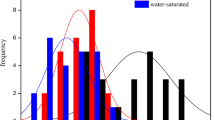Abstract
Shallow gas is a potential risk in deep-water drilling that must not be ignored, as it may cause major safety problems, such as well kicks and blowouts. Thus, the pre-drilling prediction of shallow gas is important. For this reason, this paper conducted deep-water shallow gas acoustic simulation experiments based on the characteristics of deep-water shallow soil properties and the theory of sound wave speed propagation. The results indicate that the propagation speed of sound waves in shallow gas increases with an increase in pressure and decreases with increasing porosity. Pressure and sound wave speed are basically functions of the power exponent. Combined with the theory of sound wave propagation in a saturated medium, this paper establishes a multivariate functional relationship between sound wave speed and formation pressure and porosity. The numerical simulation method is adopted to simulate shallow gas eruptions under different pressure conditions. Shallow gas pressure coefficients that fall within the ranges of 1.0–1.1, 1.1–1.2, and exceeding 1.2 are defined as low-, medium-, and high-risk, respectively, based on actual operations. This risk assessment method has been successfully applied to more than 20 deep-water wells in the South China Sea, with a prediction accuracy of over 90%.
Similar content being viewed by others
References
Adams, N. J., and Kuhlman, L. G., 1990. Case history analyses of shallow gas blowouts. SPE/IADC Drilling Conference. Houston, SPE-19917-MS.
Azadpour, M., Manaman, N. S., Kadkhodaie-Ilkhchi, A., and Sedghipour, M. R., 2015. Pore pressure prediction and modeling using well-logging data in one of the gas fields in South of Iran. Journal of Petroleum Science and Engineering, 128: 15–23.
Bachman, R. T., 1989. Estimating velocity ratio in marine sediment. The Journal of the Acoustical Society of America, 86(5): 2029–2032.
Carcione, J. M., and Tinivella, U., 2001. The seismic response to overpressure: A modelling study based on laboratory, well and seismic data. Geophysical Prospecting, 49(5): 523–539.
Fleischer, P., Orsi, T., and Richardson, M., 2003. A global survey of the distribution of free gas in marine sediments. The Journal of the Acoustical Society of America, 114(4): 2316–2317.
Gu, Z. F., Zhang, Z. X., and Wen, Z. H., 2013. Analysis of the distribution characteristics of shallow gas in the northern part of the East China Sea. Chinese Geological Society Annual Conference. Kunming, 94–95.
Hou, Z. Y., Guo, C. S., and Wang, J. Q., 2013. Surface sediments acoustic speed and porosity correlation in Nansha sea area abyssal region. Marine Sciences, 37(7): 77–82 (in Chinese with English abstract).
Kraft, B. J., Mayer, L. A., Simpkin, P., Lavoie, P., Jabs, E., Lynskey, E., et al., 2002. Calculation of in situ acoustic wave properties in marine sediments. In: Impact of Littoral Environmental Variability of Acoustic Predictions and Sonar Performance. Pace, N. G., and Jensen, F. B., eds., Springer, Dordrecht, 123–130.
Long, J. J., and Li, G. X., 2015. Theoretical relations between sound velocity and physical-mechanical properties for seafloor sediments. Acta Acustica, 40(3): 462–468 (in Chinese with English abstract).
Mayer, L. A., Kraft, B. J., Simpkin, P., Lavoie, P., Jabs, E., and Lynskey, E., 2002. In-situ determination of the variability of seafloor acoustic properties: An example from the ONR geoclutter area. In: Impact of Littoral Environmental Variability of Acoustic Predictions and Sonar Performance. Pace, N. G., and Jensen, F. B., eds., Springer, Dordrecht, 115–122.
Savvides, C., Tam, V., Os, J. E., Hansen, O., van Wingerden, K., and Renoult, J., 2001. Dispersion of fuel in offshore modules: Comparison of predictions using FLACS and full-scale experiments. Major Hazards Offshore. ERA, ISBN0700807489.
Wang, H. H., Yang, J., Li, L., Xu, J. J., Meng, L. Y., Hong, J. J., et al., 2019. An acoustic approach to identify shallow gas and evaluate drilling risk in deep water based on simulation experiment study. The 29th International Ocean and Polar Engineering Conference. Honolulu, ISOPE-I-19–601.
Weber, M. E., Niessen, F., Kuhn, G., and Wiedicke, M., 1997. Calibration and application of marine sedimentary physical properties using a multi-sensor core logger. Marine Geology, 136(3–4): 151–172.
Yang, J., Zhang, B. L., Zhou, B., Xu, P., and Tian, R. R., 2015. Geological disaster acoustic wave identification and prediction technology of deepwater shallow gas. Oil Drilling & Production Technology, 37(1): 143–146 (in Chinese with English abstract).
Zou, D. P., Wu, B. H., and Lu, B., 2007. A research on error analysis of seabed sediment porosity by calculation method and sonic speed retrieval method. Journal of Tropical Oceanography, 26(4): 32–36.
Acknowledgements
The study is supported by the National Natural Science Foundation Project ‘Research on the Evolution Mechanism of Bearing Capacity of Deep-Water Oil and Gas Well Conduit’ (No. 51774301) and CNOOC Joint Research Project ‘Geotechnical Engineering Parameters Prediction Experiment Based on Acoustic Characteristics of Shallow Layer in the South China Sea’ (No. CCL2020RCPS0120 XNN).
Author information
Authors and Affiliations
Corresponding author
Rights and permissions
About this article
Cite this article
Yang, J., Wu, S., Tong, G. et al. Acoustic Prediction and Risk Evaluation of Shallow Gas in Deep-Water Areas. J. Ocean Univ. China 21, 1147–1153 (2022). https://doi.org/10.1007/s11802-022-4790-z
Received:
Revised:
Accepted:
Published:
Issue Date:
DOI: https://doi.org/10.1007/s11802-022-4790-z




